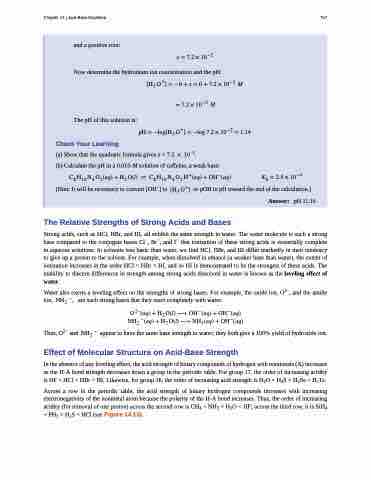Page 767 - Chemistry--atom first
P. 767
Chapter 14 | Acid-Base Equilibria 757
and a positive root:
� � ��� � ���� Now determine the hydronium ion concentration and the pH:
The pH of this solution is:
Check Your Learning
������� ��������������� � ��������� �
�� � ������� ��� � ���� ��� � ���� � ����
(a) Show that the quadratic formula gives x = 7.2 � 10−2.
(b) Calculate the pH in a 0.010-M solution of caffeine, a weak base:
�������������������� � �����������������������
(Hint: It will be necessary to convert [OH−] to ��� ��� or pOH to pH toward the end of the calculation.)
�� ��������� Answer: pH 11.16
The Relative Strengths of Strong Acids and Bases
Strong acids, such as HCl, HBr, and HI, all exhibit the same strength in water. The water molecule is such a strong base compared to the conjugate bases Cl−, Br−, and I− that ionization of these strong acids is essentially complete in aqueous solutions. In solvents less basic than water, we find HCl, HBr, and HI differ markedly in their tendency to give up a proton to the solvent. For example, when dissolved in ethanol (a weaker base than water), the extent of ionization increases in the order HCl < HBr < HI, and so HI is demonstrated to be the strongest of these acids. The inability to discern differences in strength among strong acids dissolved in water is known as the leveling effect of water.
Water also exerts a leveling effect on the strengths of strong bases. For example, the oxide ion, O2−, and the amide ion, ��� �� are such strong bases that they react completely with water:
������� � �� ���� � ������� � ������� ��� ����� � �� ���� � ������� � �������
Thus, O2− and ��� � appear to have the same base strength in water; they both give a 100% yield of hydroxide ion. Effect of Molecular Structure on Acid-Base Strength
In the absence of any leveling effect, the acid strength of binary compounds of hydrogen with nonmetals (A) increases as the H-A bond strength decreases down a group in the periodic table. For group 17, the order of increasing acidity is HF < HCl < HBr < HI. Likewise, for group 16, the order of increasing acid strength is H2O < H2S < H2Se < H2Te.
Across a row in the periodic table, the acid strength of binary hydrogen compounds increases with increasing electronegativity of the nonmetal atom because the polarity of the H-A bond increases. Thus, the order of increasing acidity (for removal of one proton) across the second row is CH4 < NH3 < H2O < HF; across the third row, it is SiH4 < PH3 < H2S < HCl (see Figure 14.13).


